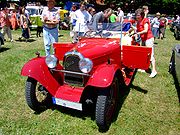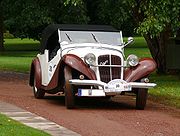.gif)
Aero (automobile)
Encyclopedia
The Aero was a Czechoslovak
automobile
, manufactured between 1929 and 1947 by a well-known aircraft
and car-body company owned by Dr. Kabes in Praha-Vysocany. Now Aero Vodochody
produces aircraft only.
, had a 499 cc single-cylinder
two-stroke engine with water cooling. Drive was to the rear axle through a 3 speed gearbox to a back axle without differential. Body styles were a roadster, cabriolet and coupé all with two seats in the front and one in the rear. About 1500 were made.
 The next model in 1932, the Type 20, was a 660 cc vertical twin with, among other improvements, four wheel brakes. The most common body was a two door three seat roadster but four door saloons were also made using steel covered timber framed coachwork. A 999 cc 26 bhp engine was available from 1932.
The next model in 1932, the Type 20, was a 660 cc vertical twin with, among other improvements, four wheel brakes. The most common body was a two door three seat roadster but four door saloons were also made using steel covered timber framed coachwork. A 999 cc 26 bhp engine was available from 1932.

 In 1934 the Type 30 was announced with a 998 cc 26 bhp twin-cylinder engine, front wheel drive and all independent suspension. The car could reach 65 mph (105 km/h). About 3000 were made before the war.
In 1934 the Type 30 was announced with a 998 cc 26 bhp twin-cylinder engine, front wheel drive and all independent suspension. The car could reach 65 mph (105 km/h). About 3000 were made before the war.
(37 kW two-stroke engine with alloy cylinder head and was capable of reaching 78 mph (125 km/h).
After the war the company made the Type 30 until 1947. About 500 were produced with 200 going to France and 100 to Belgium. Design work had been done on a new post war range which would have had hydraulic brakes and four speed gearboxes but they did not go into production. Aero disappeared when the Czechoslovak motor industry was nationalised.
 Many famous drivers won many events in Aero cars including a third in category on the 1934 Monte Carlo Rally
Many famous drivers won many events in Aero cars including a third in category on the 1934 Monte Carlo Rally
.
Czechoslovak Republic
Czechoslovak Republic was the official name of Czechoslovakia between 1918 and 1938 and between 1945 and 1960. See*First Czechoslovak Republic*Second Czechoslovak Republic...
automobile
Automobile
An automobile, autocar, motor car or car is a wheeled motor vehicle used for transporting passengers, which also carries its own engine or motor...
, manufactured between 1929 and 1947 by a well-known aircraft
Aircraft
An aircraft is a vehicle that is able to fly by gaining support from the air, or, in general, the atmosphere of a planet. An aircraft counters the force of gravity by using either static lift or by using the dynamic lift of an airfoil, or in a few cases the downward thrust from jet engines.Although...
and car-body company owned by Dr. Kabes in Praha-Vysocany. Now Aero Vodochody
Aero Vodochody
Aero Vodochody is a Czech aircraft company, active from 1919, notable for producing the L-29 Delfin, L-39 Albatros, L-59 Super Albatros and the L-159 Alca....
produces aircraft only.
Aero 500
The original model, the Aero Type 500 cyclecarCyclecar
Cyclecars were small, generally inexpensive cars manufactured mainly between 1910 and the late 1920s.-General description:Cyclecars were propelled by single cylinder, V-twin or more rarely four cylinder engines, often air cooled. Sometimes these had been originally used in motorcycles and other...
, had a 499 cc single-cylinder
Cylinder (engine)
A cylinder is the central working part of a reciprocating engine or pump, the space in which a piston travels. Multiple cylinders are commonly arranged side by side in a bank, or engine block, which is typically cast from aluminum or cast iron before receiving precision machine work...
two-stroke engine with water cooling. Drive was to the rear axle through a 3 speed gearbox to a back axle without differential. Body styles were a roadster, cabriolet and coupé all with two seats in the front and one in the rear. About 1500 were made.
Aero 662

Aero 30


Aero 50
The last model, the Type 50, also front-wheel-drive, had a 1997 cc four-cylinder 50 PSHorsepower
Horsepower is the name of several units of measurement of power. The most common definitions equal between 735.5 and 750 watts.Horsepower was originally defined to compare the output of steam engines with the power of draft horses in continuous operation. The unit was widely adopted to measure the...
(37 kW two-stroke engine with alloy cylinder head and was capable of reaching 78 mph (125 km/h).
After the war the company made the Type 30 until 1947. About 500 were produced with 200 going to France and 100 to Belgium. Design work had been done on a new post war range which would have had hydraulic brakes and four speed gearboxes but they did not go into production. Aero disappeared when the Czechoslovak motor industry was nationalised.
Racing cars

Monte Carlo Rally
The Monte Carlo Rally or Rally Monte Carlo is a rallying event organised each year by the Automobile Club de Monaco which also organises the Formula One Monaco Grand Prix and the Rallye Monte-Carlo Historique. The rally takes place along the French Riviera in the Principality of Monaco and...
.

